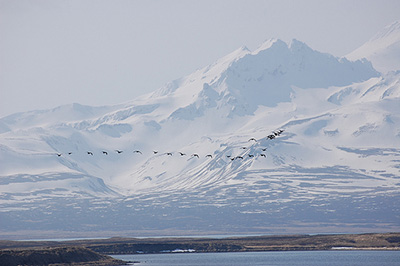
Last March, we discussed the burgeoning conflict between Senator Lisa Murkowski (R-AK) and the Department of the Interior over a proposed 20-mile gravel road in the Izembek National Wildlife Refuge. The road would be used to link the local King Cove community to an all-weather airport. Currently, residents must use hovercrafts and boats to access the airport. When we last left the situation, the Department of Interior agreed to revisit the environmental reviews on the project in exchange for Sen. Murkowski lifting her hold over the nomination of Sally Jewell to be the next Secretary of the Interior Department. Fast-forward nine months.

This past December, the now-Secretary Jewell rejected the proposal that would exchange 206 acres of land within the Izembek Refuge to use for the road while adding an additional 56,000 acres of state and tribal lands to the refuge from neighboring acreage. Secretary Jewell stated that the project would cause “irreversible damage” to the wildlife and wilderness within the refuge. Prior to the rejection of the road, the Department of Interior held more than 130 meetings with stakeholders to get a full picture of the competing interests. But like so many other policy decisions, the result has left some very unhappy people, including Alaska’s senate delegation.


Last week, Sen. Murkowski pushed the Department of Interior to reconsider the denial of the road. And here we take a brief foray into the world of the Administrative Procedure Act (APA). As the cornerstone of agency law, the APA lays out the procedures for agencies to draft and finalize the rules that carry out the intent expressed in legislation. In her letter to Interior, Sen. Murkowski stated that the agency failed to take a “hard look” at the proposal as NEPA requires and its actions were “arbitrary and capricious.” These are APA buzzwords, intended specifically to alert Interior that their decision may be challenged in court. One administrative law pillar is Chevron deference, so-called based on the 1984 Supreme Court case Chevron U.S.A. v. Natural Resources Defense Council. Without dragging you too much into the weeds, Chevron deference, at its most non-nuanced base, states that if “Congress has explicitly left a gap for the agency to fill, there is an express delegation of authority to the agency to elucidate a specific provision of the statute by regulation.” These regulations are entitled to deference by a court unless they are “arbitrary, capricious, or manifestly contrary to the statute.”
Sen. Murkowski’s letter is warning Interior that she believes the rejected land swap was improper and not appropriate for Chevron deference by a court. Whether it actually gets to that point, we shall see. But when you read about the phrase “arbitrary and capricious” referenced by policymakers, you know there is a specific reason beyond someone’s love of a thesaurus.
In the meantime, Sen. Mark Begich (D-AK) has introduced a bill, S. 1929, specifically approving the road and mandating the current proposed land swap. The road would be lined with barriers and limited to use for health and safety purposes, not commercial travel. There is no current action on the bill and, for the time being, Sen. Murkowski has declined to co-sponsor it. Regardless of the outcome of the Izembek land swap, relations between the Interior Department and the Alaskan delegation have cooled as a result of Sec. Jewell’s denial. Not an ideal circumstance for an agency that oversees hundreds of millions of acres of federal lands and a state that alone contains 222 million acres of it.